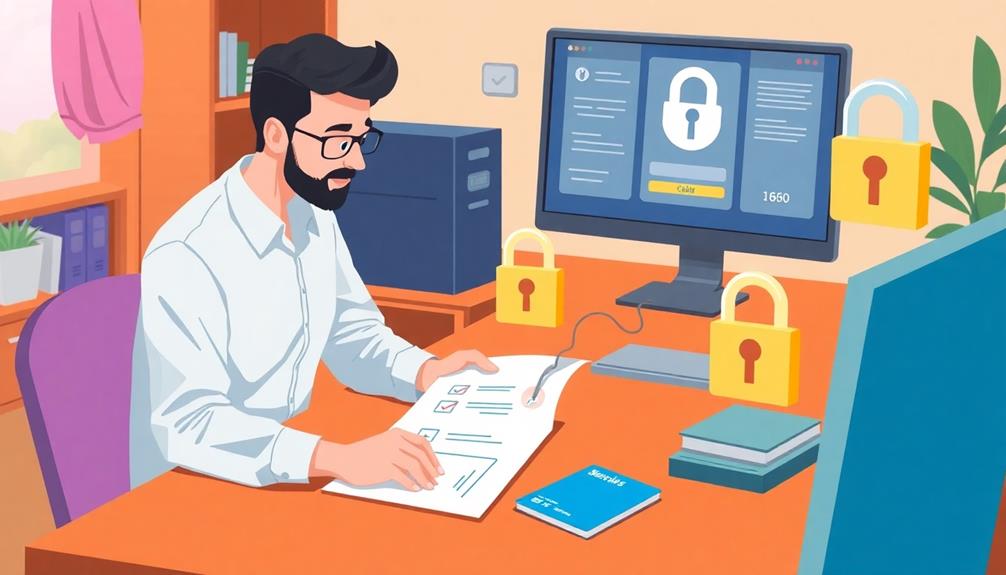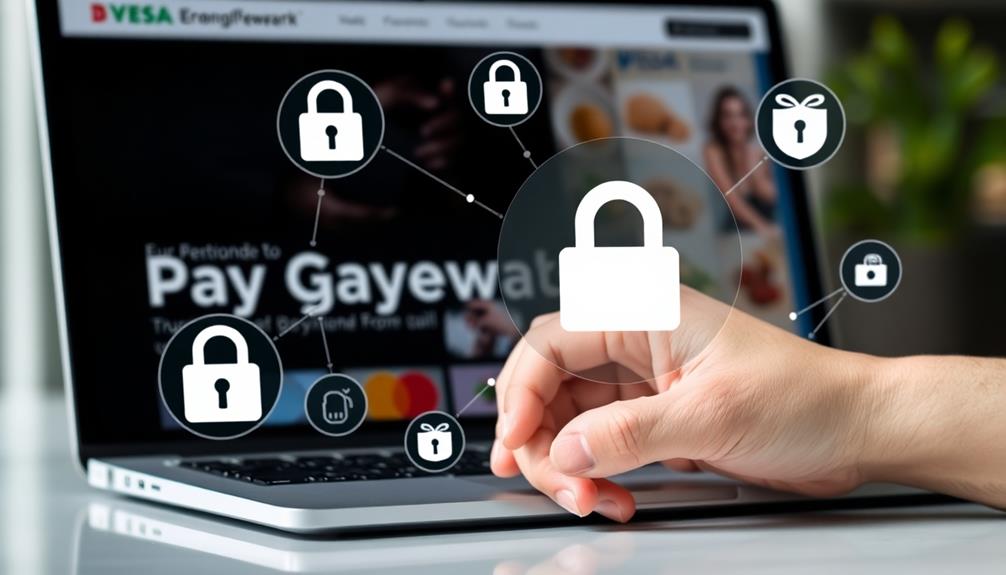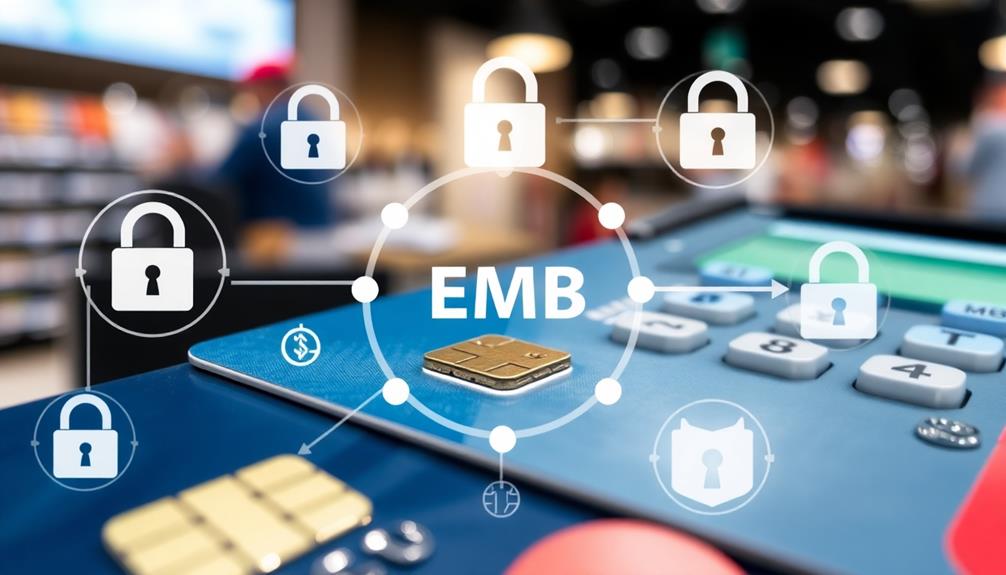To achieve PCI DSS compliance as a small business, start by identifying your compliance level based on transaction volume. Next, complete the Self-Assessment Questionnaire (SAQ) annually and conduct quarterly vulnerability scans through an Approved Scanning Vendor. You'll need to implement strong security measures like encryption and firewalls to protect customer data. Keep thorough documentation of your efforts for audits. While the costs can range from $1,000 to over $300,000, the benefits include reduced risk of data breaches and increased customer trust. There's much more to explore, so keep going and discover additional steps and resources.
Key Takeaways
- Determine your PCI compliance level based on annual transaction volume, which ranges from Level 1 to Level 4.
- Complete and submit the Self-Assessment Questionnaire (SAQ) annually to evaluate your compliance status.
- Conduct quarterly vulnerability scans through an Approved Scanning Vendor (ASV) to identify security weaknesses.
- Implement essential security controls such as encryption, firewalls, and secure networks to protect cardholder data.
- Maintain thorough documentation of your compliance efforts to facilitate audits and demonstrate adherence to PCI DSS standards.
Understanding PCI DSS Compliance

Understanding PCI DSS compliance is essential for small businesses that handle credit card transactions. The Payment Card Industry Data Security Standard (PCI DSS) is designed to protect cardholder data and minimize the risk of data breaches.
For most small businesses, you'll fall under compliance levels 3 or 4, depending on your annual transaction volume. Each level has specific security requirements you'll need to meet, similar to how maintaining a financial budget is vital for managing your business's finances effectively.
These requirements include maintaining a secure network, encrypting cardholder data, and regularly monitoring and testing your systems. Compliance isn't just a box to check—it's vital for safeguarding your business and your customers.
Non-compliance can result in hefty financial penalties ranging from $5,000 to $100,000 per month, not to mention the reputational damage that could follow.
To stay compliant, you'll need to perform annual audits and document your compliance efforts meticulously. Keep your security measures updated to adapt to evolving threats.
Importance for Small Businesses

The importance of PCI DSS compliance for small businesses can't be overstated. With a staggering 43% of cyber attacks targeting small businesses, it's vital for you to prioritize PCI compliance to protect sensitive payment information.
Neglecting these requirements can expose your business to significant financial penalties, ranging from $5,000 to $100,000 per month, making compliance not just a legal obligation but a financial necessity.
Additionally, as the global political climate shifts and cyber threats become more sophisticated, the need for robust security measures is more pressing than ever, especially in light of recent rising tensions among major powers that could lead to increased cyber vulnerabilities.
Here are a few key reasons why PCI compliance matters:
- Protects Against Data Breaches: Compliance helps mitigate risks associated with data breaches, which small businesses faced 699 times in a recent year.
- Builds Customer Trust: Demonstrating that you can securely handle payment information enhances customer confidence and loyalty to your brand.
- Enhances Security Measures: Adhering to PCI DSS requirements means implementing robust security measures to defend against evolving cyber threats.
Steps to Achieve Compliance

Achieving PCI DSS compliance might seem challenging, but breaking it down into manageable steps can simplify the process.
First, identify your PCI compliance level based on your annual transaction volume; this ranges from Level 1 for over 6 million transactions to Level 4 for under 20,000. To enhance your business resilience, consider diversifying your income streams through digital entrepreneurship, which can help mitigate some risks associated with payment processing.
Next, complete the relevant Self-Assessment Questionnaire (SAQ) tailored to your business type. Make certain it's signed by a company officer and submitted annually.
After you've submitted the SAQ, conduct quarterly vulnerability scans through an Approved Scanning Vendor (ASV) to guarantee your payment systems and networks are secure.
Implement necessary security controls, including encryption and firewalls, to protect sensitive data.
Don't forget to maintain thorough documentation of compliance efforts, as this is essential for audits.
Financial Implications of Compliance

How much could PCI DSS compliance impact your bottom line? For small businesses, the financial implications can be significant. The average cost of achieving PCI compliance may exceed $300,000, with annual expenses ranging from $1,000 to $10,000 based on your size and existing security measures.
Understanding production quantity variance is essential, as it can also affect your financial performance in the context of compliance. Non-compliance can lead to penalties between $5,000 and $100,000 per month, which can cripple your finances.
Here are some key financial considerations:
- Compliance costs: Expect to pay for vulnerability scans ($200 to $1,000 annually) and QSA fees starting at $10,000.
- Data breach impact: A breach can result in costs that may threaten your business's survival.
- Transaction fees: Investing in compliance can lower these fees with compliant payment processors.
Ultimately, investing in PCI compliance not only helps mitigate the risk of hefty fines but also protects your business from the devastating financial impact of a data breach.
Benefits of Compliance

Investing in PCI DSS compliance brings numerous benefits that can greatly enhance your small business's success. By ensuring that sensitive payment information is securely handled, you not only protect your customers but also build trust. With 43% of cyber attacks targeting small businesses, enhancing your security practices is essential.
Here are some key compliance benefits:
| Benefit | Description |
|---|---|
| Reduced Data Breaches | PCI compliance can notably lower the risk of costly data breaches. |
| Lower Transaction Fees | Compliance may lead to reduced fees from payment processors. |
| Enhanced Customer Trust | Secure handling of data fosters loyalty and attracts new customers. |
| Improved Reputation | A commitment to security enhances your business reputation. |
Achieving PCI compliance not only minimizes the financial impact of data breaches—averaging $200,000 per incident—but also positions your small business as a leader in security. This proactive approach helps mitigate evolving cybersecurity threats, making compliance not just a regulatory obligation, but a strategic advantage for your business.
Compliance Automation Tools

Maneuvering the complexities of PCI DSS compliance can feel overwhelming, but compliance automation tools simplify the process for small businesses.
These tools, like Drata, Vanta, and Secureframe, help you streamline the process by automating essential tasks such as documentation and compliance reporting.
Additionally, leveraging tools to monitor your website's performance can be beneficial, as they guarantee that your digital presence remains compliant and optimized for user experience, which is vital for maintaining technical SEO.
Here are a few key benefits of using compliance automation tools:
- Documentation Automation: Save time with pre-built policy templates that make it easier to create necessary compliance documents.
- Continuous Monitoring: Track your compliance status in real-time to quickly identify gaps and prioritize improvements.
- Cost Reduction: Lower the costs associated with audits and vulnerability scans through efficient compliance management.
Frequently Asked Questions
What Are the Steps for PCI DSS Compliance?
To achieve PCI DSS compliance, you'll identify your compliance level, complete the Self-Assessment Questionnaire, conduct quarterly network scans, submit an Attestation of Compliance, and maintain thorough documentation of your security measures and audits.
How Does a Small Business Become PCI Compliant?
To become PCI compliant, you'll assess your transaction volume, complete the Self-Assessment Questionnaire, implement security measures like encryption, conduct quarterly scans, and submit required documentation annually to guarantee ongoing compliance.
Can I Do PCI Compliance Myself?
Think of PCI compliance like steering through a maze. Yes, you can tackle it yourself! Just confirm you meet all requirements, document your efforts, and consider help from experts to keep your path clear and secure.
What Are the 4 Levels of PCI Compliance?
The four levels of PCI compliance are based on transaction volume: Level 1 for over 6 million, Level 2 for 1-6 million, Level 3 for 20,000-1 million e-commerce, and Level 4 for under 20,000.
Conclusion
In the journey toward PCI DSS compliance, think of yourself as a captain steering through turbulent seas. The path may seem intimidating, but the rewards are worth the effort. By safeguarding your customers' data, you not only protect your business but also build trust and loyalty. Embrace the process, leverage automation tools, and remember that each step you take brings you closer to calmer waters and a more secure future. Your business deserves to thrive—set sail today!











